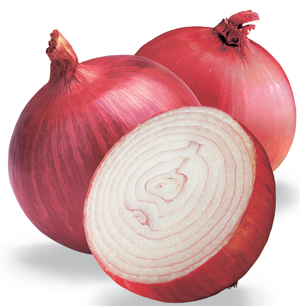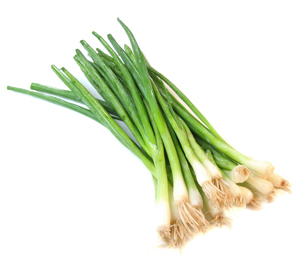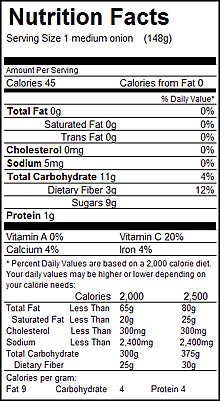Contents:
Common Names | Parts Usually Used | Plant(s) & Culture | Where Found | Medicinal Properties
Legends, Myths and Stories | Uses | Formulas or Dosages | Nutrient Content | How Sold | Warning | Bibliography
Scientific Names

- Allium cepa L.
- Liliaceae
- Lily family
Common Names
- Hui-hui-ts’ung (Chinese name)
- Hu-ts’ung (Chinese name)
- Onion
Parts Usually Used
The bulb
Back to Top

Description of Plant(s) and Culture
Onion is a biennial or perennial plant; the bulb itself is an underground part of the stem, the above-ground part of which is hollow and blue-green. The leaves are the same color and hollow, but shorter than the stem. They dilate to surround the stem at the bottom. Greenish-white flowers grow in a rounded, umbellate cluster from June to August, producing tiny bulbs as fruit.
Other varieties: Egyptian onion (Allium cepa var. viviparum) makes bulbs on top of plant as well as bottom of plant; Welsh onion (A. fistulosum) has multiple shoots with many flowers, Chinese called this onion Ts’ung; Elephant garlic (A. ampeloprasum) has tall stalks with large, showy, white flowers; Chinese chives (A. tuberosum) grows in clumps of long thin leaves; Chives (A. schoenprasum) grows in clumps with long, thin, grasslike and hollow leaves; Ramp (A. tricoccum) resembles poisonous lily of the valley, do not confuse them: Giant chives (A. sibericum) also known as Chinese chives.
Back to Top
Where Found
Mostly cultivated but also found wild in numerous varieties. Onions grow along streams and are found on mountains. Wild onions are gathered in May and June. Eaten as they are found, both bulbs and leaves, after washing.
Back to Top
Medicinal Properties
Anthelmintic, antiseptic, antispasmodic, carminative, diuretic, expectorant, stomachic, tonic
Back to Top

Legends, Myths and Stories
Onions were a favorite food of the Egyptian slaves. According to the Greek historian Herodotus, 9 tons of gold was given in payment for the onion consumed by the slaves building the great pyramids. The Egyptians themselves held onions in high regard, for Pliny reports that they “make their oaths” by garlic and onions. The regarded the brittle brown skin which envelops the onion bulb as a symbol of the universe.
Later, Europeans had a practice of suspending onion slices in each room to purge “evil spirits” from a house. The slices were collected and burned each day. One herbalist recorded a story attributing the immunization to garlic. The conflicting stories serve to demonstrate the inherent similarities of the two herbs. Culpeper noted onions served as well as garlic.
Try eating parsley to avoid onion breath. Or Chlorophyll tablets can help eliminate the odor.
Personally, when I was a child, my uncle had a pet spider monkey. Every now and then, he would give the animal, named Chipper, a raw onion. Chipper would scrape the layers of the onion to get the juice out and would rub it on himself to neutralize the “monkey odor.” Interestingly, it actually did work.
Back to Top

Uses
Onion juice (or a decoction or extract) is used as a diuretic or expectorant agent, but it has been used for ages for the other purposes indicated. Boiled, it is used to eliminate fluid retention in the system. Onion helps to end putrefactive and fermentation processes in the gastrointestinal tract. It is said to strengthen the heart and tends to lower blood pressure, good for scalds and burns; blemishes, spots, calluses, warts, athletes foot, sprains, piles, and marks in the skin. Helps restore sexual potency which has been impaired by illness or mental stress, increases sperm. Half an onion cut small and eaten with bread will relieve gas pains and heartburn. Onion juice mixed with honey is good for colds, flu, hoarseness and coughs. Externally, onion juice can be applied to suppurating wounds or sores, boils. For gout, thrombosis, and diabetes, high cholesterol, helps prevent blood clots, helps restore sexual impotency, as well as hardening of the arteries, onions as a food are a vital part of the treatment. Onion has a good effect on appetite, dandruff and loss of hair, colds, flu, hay fever, whooping cough, laryngitis, yellow fever, pneumonia, fever, colic, bladder cramps, earache, headache, chill, kills worms, and toothache.
Place fresh slices on insect stings for rapid relief. Also use to relieve nettle rash or hives (urticaria) caused by food allergies.
Back to Top
Formulas or Dosages
Juice: take 1 tsp., 3 or 4 times a day.
To make onion juice, puree one raw onion in a blender or food processor and strain through a cheesecloth. Store in the refrigerator. For colds, mix warm juice with 2 tsp. honey.
Cold extract: soak a chopped onion in 1 cup water for 24 hours and strain. Take 1/2 cup per day.
Decoction: boil a medium-size, chopped onion in a little more than a cup of water until 1 cup liquid remains. Take 1 tbsp., several times a day for several days.
Back to Top
Nutrient Content
Iron, sulfur, phosphorus, calcium, rich in vitamin C

How Sold
In the supermarket produce area
Back to Top
Warning
Breast-feeding an infant, mothers should avoid onions because they could cause the baby to suffer colic.
Back to Top
Bibliography
![]() The Complete Medicinal Herbal
The Complete Medicinal Herbal, by Penelope Ody, Dorling Kindersley, Inc, 232 Madison Avenue, New York, NY 10016, First American Edition, copyright 1993
![]() Back to Eden
Back to Eden, by Jethro Kloss; Back to Eden Publishing Co., Loma Linda, CA 92354, Original copyright 1939, revised edition 1994
![]() Chinese Medicinal Herbs
Chinese Medicinal Herbs, compiled by Shih-Chen Li, Georgetown Press, San Francisco, California, 1973.
![]() Culpeper’s Complete Herbal & English Physician: Updated With 117 Modern Herbs
Culpeper’s Complete Herbal & English Physician: Updated With 117 Modern Herbs, by Nicholas Culpeper, Meyerbooks, publisher, PO Box 427, Glenwood, Illinois 60425, 1990, (reprint of 1814)
![]() The Herbalist Almanac
The Herbalist Almanac, by Clarence Meyer, Meyerbooks, publisher, PO Box 427, Glenwood, Illinois 60425, copyright 1988, fifth printing, 1994
![]() The Herb Book
The Herb Book, by John Lust, Bantam Books, 666 Fifth Avenue, New York, NY. copyright 1974.
Herbal Gardening, compiled by The Robison York State Herb Garden, Cornell Plantations, Matthaei Botanical Gardens of the University of Michigan, University of California Botanical Garden, Berkeley., Pantheon Books, Knopf Publishing Group, New York, 1994, first edition
 Earl Mindell’s Herb Bible
Earl Mindell’s Herb Bible, by Earl Mindell, R.Ph., Ph.D., Simon & Schuster/Fireside, Rockefeller Center 1230 Avenue of the Americas, New York, New York 10020
 How Indians Use Wild Plants for Food, Medicine & Crafts
How Indians Use Wild Plants for Food, Medicine & Crafts, by Frances Densmore, Dover Publications, Inc., 180 Varick Street, New York, NY 10014, first printed by the United States Government Printing Office, Washington, in 1928, this Dover edition 1974
![]() Indian Herbalogy of North America
Indian Herbalogy of North America, by Alma R. Hutchens, Shambala Publications, Inc., Horticultural Hall, 300 Massachusetts Avenue, Boston, Massachusetts 02115, 1973
![]() Indian Uses of Native Plants
Indian Uses of Native Plants, by Edith Van Allen Murphey, Meyerbooks, publisher, PO Box 427, Glenwood, Illinois 60425, copyright 1958, print 1990
![]() The Nature Doctor: A Manual of Traditional and Complementary Medicine
The Nature Doctor: A Manual of Traditional and Complementary Medicine, by Dr. H.C.A. Vogel; Keats Publishing, Inc., 27 Pine Street (Box 876) New Canaan, CT. 06840-0876. Copyright Verlag A. Vogel, Teufen (AR) Switzerland 1952, 1991
 Old Ways Rediscovered
Old Ways Rediscovered, by Clarence Meyer, Meyerbooks, publisher, PO Box 427, Glenwood, Illinois 60425, published from 1954, print 1988
![]() Planetary Herbology
Planetary Herbology, by Michael Tierra, C.A., N.D., O.M.D., Lotus Press, PO Box 325, Twin Lakes. WI 53181., Copyright 1988, published 1992
 Secrets of the Chinese Herbalists
Secrets of the Chinese Herbalists, by Richard Lucas, Parker Publishing Company, Inc., West Nyack, NY, 1987.
![]() The Yoga of Herbs: An Ayurvedic Guide to Herbal Medicine
The Yoga of Herbs: An Ayurvedic Guide to Herbal Medicine, by Dr. David Frawley & Dr. Vasant Lad, Lotus Press, Twin Lakes, Wisconsin, Second edition, 1988.
![]() Webster’s New World Dictionary
Webster’s New World Dictionary, Third College Edition, Victoria Neufeldt, Editor in Chief, New World Dictionaries: A Division of Simon & Schuster, Inc., 15 Columbus Circle, New York, NY 10023
 The Rodale Herb Book: How to Use, Grow, and Buy Nature’s Miracle Plants (An Organic gardening and farming book)
The Rodale Herb Book: How to Use, Grow, and Buy Nature’s Miracle Plants (An Organic gardening and farming book), edited by William H. Hylton, Rodale Press, Inc. Emmaus, PA, 18049., 1974
